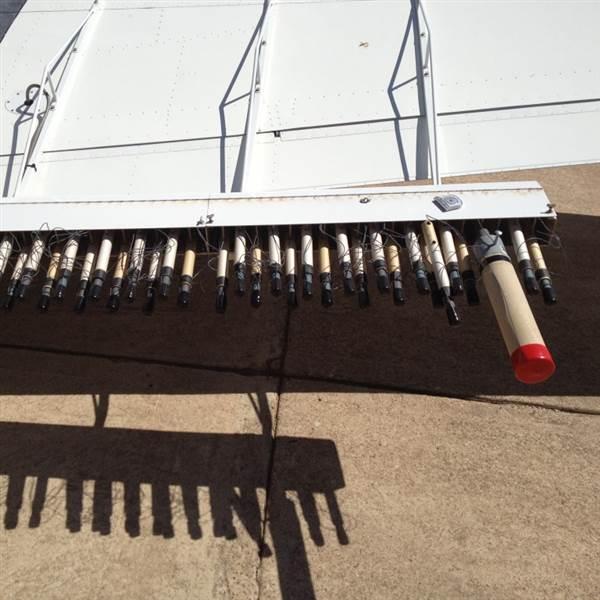
Fatal accidents involving pilots flying too near thunderstorms usually go something like this: Updrafts of 1,500 feet per minute to 2,000 feet per minute pull the aircraft into the storm that is churning inside like a blender. The aircraft is torn apart and pieces are seen by witnesses falling out of the overcast.
Weather modification pilots fly into most of that on purpose. They get within 500 feet of the base of a thunderstorm or fly above the cloud. Those pilots flying beneath the storm are occasionally pulled into it by the same updrafts that lift their cloud-seeding chemicals into the storm. It is not uncommon to be pummeled by hail. The difference is that cloud-seeding pilots nearly always survive.
For their efforts, cloud-seeding pilots are paid modestly, but there are other satisfying rewards. If they seed a cloud—usually by burning a flare emitting silver iodide that gets sucked into the storm cloud—and see cloud-to-ground lightning when they are finished, it’s a success. It’s a little like making a level, 360-degree turn and being proud of the buffet from the airplane’s own wake at the end because that’s proof the pilot kept an exact altitude. In this case it means the storm has increased in intensity and will produce an average of 10 to 15 percent more rain. That translates to West Texas getting an inch to two inches more rain during the season.
The West Texas Weather Modification Association is a nonprofit consortium of six local counties that pay four cents per acre to support rainmaking. The group uses four single-engine Piper Comanche 250 aircraft based near Pecos, Texas, with up to 140 silver-iodide-emitting flares mounted on rails just above the trailing edge of each wing. The flares remain attached as they burn.
“From the outside, quite frankly, they look pretty ugly because most of them have been in a hailstorm and a lot of the wings look like golf balls [hit them]. The mechanics of the airplane are very sound. The instrumentation is good,” said Ralph “Fil” Filburn, the group’s chief pilot. He’s the only pilot to receive a salary. Other pilots are paid $150 an hour. Pilots working at another of the nation’s 20 weather modification organizations, Seeding Operations and Atmospheric Research (SOAR) in Wichita Falls, Texas, may make $2,500 to $10,000 per month, or as little at $450 to $600, seeding clouds by ejecting burning silver iodide flares from multiengine aircraft.
As chief pilot one of Filburn’s duties is to find and train pilots. Most of the training involves how best to work with the meteorologist on the ground in order to find the upflow needed to seed the storm.
“You have to re-orient new pilots,” Filburn said. “Throughout your flying career you are taught not to mess with thunderstorms and weather fronts. Land, wait for them to go by, and then take off again. What we have to do is orient the pilots so that they will become comfortable in approaching...small thunderstorms that we try to make [into] big thunderstorms.
“As pilot you are vice president in charge of safety.” —Ralph “Fil” Filburn, chief pilot, West Texas Weather Modification Association“Typically our insurance likes to see people with obviously a commercial license if you are going to pay them, 750 hours of flying time, and it’s desirable that they have time in a Comanche 250, but we can do that during the process of training,” Filburn said.
To find a cloud, stay safe, determine where the updrafts are, and stay safe some more, Filburn’s pilots work with meteorologists on the ground with access to radar. The meteorologists help the pilots find upflow and warn of hail. Generally, a pilot will fire two flares, each one containing 27 grams of silver iodide, and back off to see what will happen.
“One of the biggest things I teach the pilots as they go into training is, their safety is the most important thing. The meteorologist is kind of the mission commander. But as pilot you are vice president in charge of safety. You don’t do anything that you’re not comfortable doing,” Filburn said.
“It’s not a difficult thing to do but one of the things you have to instill is when do you quit? When do you stop doing this because it’s getting marginal or too dangerous? One of the things I stress…is we don’t seed clouds that are lower than 5,000 feet above the ground level. We’re very conscious of microbursts—and we don’t have them very often, but sometimes we do. The last thing in the world you want to be in is a Comanche 250 in the middle of a microburst 3,000 feet above the ground. It’s going to take you, shove you right into the ground,” Filburn said.
Normally the aircraft are safely 500 feet below the base of the cloud and don’t get pulled into the storm they are trying to grow. That is not always the case.
“One of the things I teach them is to take the heading bug on the HSI [horizontal situation indicator] and put it on their bug-out heading,” Filburn said. “If they get pulled up into the cloud, turn to that heading, which is usually the last heading you had to get to clear air, and begin a descent. The descent is up to and including idle power, with the landing gear out, and put the flaps out for drag and get started down. We typically seed at 100 to 110 miles an hour so we’re below the maneuvering speed.” If the aircraft is traveling in excess of its maneuvering speed, structural damage could occur with full deflection of the controls.
“What we’re looking for is small storms, sometimes a front that is coming through, where at the leading edge of the storm, or the leading edge of the front, you are getting inflow into the cloud. That is warm, moist air being pulled up into the leading edge of the base of the cloud that rises up into the cloud and cools to form supercooled water, and them forms ice. A thunderstorm will not produce rain until you have ice in it,” Filburn said.
“You know you’ve done your job when you arrive at a cloud that’s forming, find inflow and begin to seed it, and when you’re finished with your initial dose [you] get cloud-to-ground lightning. The ice has formed. You’ve got the storm cooking,” Filburn added.





